Frost Protection - UTL Repository
Frost Protection - UTL Repository
Frost Protection - UTL Repository
Create successful ePaper yourself
Turn your PDF publications into a flip-book with our unique Google optimized e-Paper software.
PASSIVE PROTECTION METHODS<br />
of culm rolled around trunks for young trees; and (4) roofing tiles, adobe<br />
shelters, leaves of plants, etc., for small plants. For rows of plants, the methods<br />
include (1) larger horizontal or inclined mats for tree rows; (2) shelters forming<br />
a half hut with vertical wall facing the predominant wind direction; and (3) straw<br />
layers over horticultural nurseries, where the mats and shelters use local<br />
materials (e.g. straw, bamboo, wood, boards, hay, etc.) (Abreu, 1985).<br />
Although the materials used for coverings generally are inexpensive, the<br />
manpower needed to apply the materials can be cost prohibitive. Generally, this<br />
method is only used on small plantings or on small plants that do not require a<br />
solid frame. Sometimes, disease problems occur due to poor ventilation.<br />
Row covers are sometimes used for protection of high value crops. Woven and<br />
spun-bonded polypropylene plastics are typically used and the degree of<br />
protection varies with the thickness of the material (e.g. from 1 °C for thin sheet<br />
plastic to 5 °C for thick plastic). White plastic provides some protection and it<br />
is sometimes used for nursery stock. It is not typically used for fruit and<br />
vegetable crop protection. Schultz (1961) reported that 1.2 m wide, black<br />
polyethylene sheets were used to cover grapevine rows and it increased the air<br />
temperature next to the foliage by about 1.5 °C.<br />
Transparent plastic covers allow sunlight to pass through during the day and<br />
slow heat loss from the surface at night. The downward radiation from the sky<br />
at night depends on the apparent temperature of the sky, so when covered with<br />
plastic, the downward radiation depends mainly on the plastic cover<br />
temperature. Since the sky is much colder than air near the ground and the plastic<br />
will have a temperature closer to the air temperature, the downward radiation is<br />
enhanced by covering the plants. If condensation forms underneath the plastic,<br />
this will release latent heat, warm the plastic and provide even more protection.<br />
Under advection frost conditions, the plastic covers can also block the wind and<br />
provide some protection. Some characteristics for above-plant row covers are<br />
provided in Table 6.1.<br />
A wide variety of methods are used to cover the plants and to anchor the<br />
plastic. To keep the plants from being touched, plastic covers are sometimes<br />
mounted on hoops. Otherwise, the plastic can float on the canopy and rise up as<br />
the crops grow, but disease problems are more likely. PVC greenhouses are<br />
sometimes used to protect citrus. The plastic can be used up to three years<br />
depending on the structural design and quality of the plastic.<br />
A common problem is that the labour requirements for applying covers are<br />
high and therefore the crop value must be high. Also, the plants become less<br />
hardy against freezing and there are often problems with pollination if the covers<br />
131


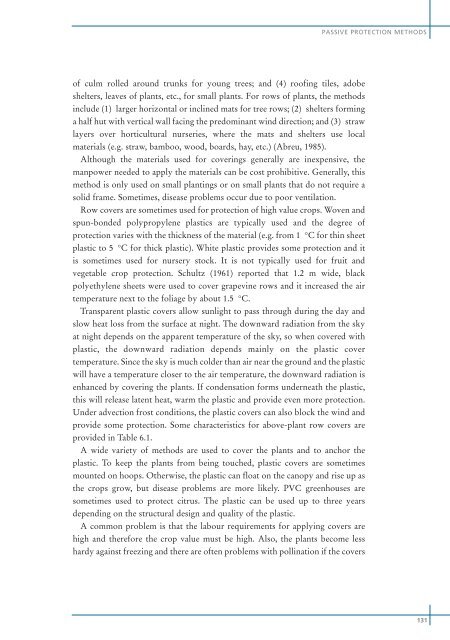
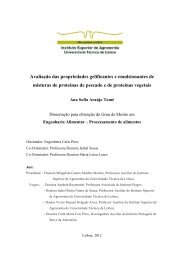
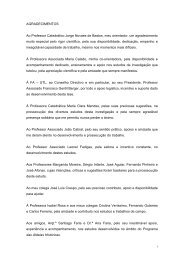

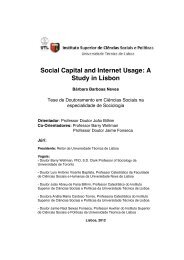
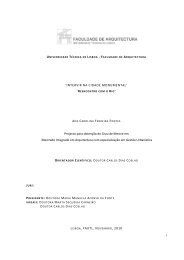
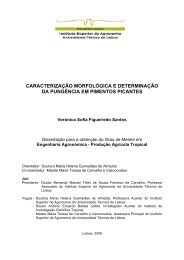

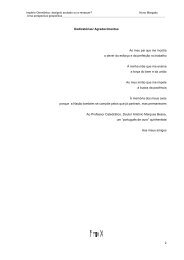
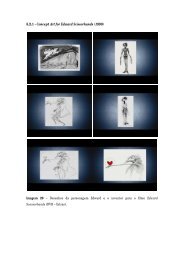
![Tese - Es..[1].pdf - UTL Repository - Universidade Técnica de Lisboa](https://img.yumpu.com/25707135/1/184x260/tese-es1pdf-utl-repository-universidade-taccnica-de-lisboa.jpg?quality=85)


